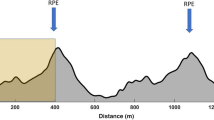Abstract
The purpose of this study was to investigate the frequency speed of kick test (FSKT) responsiveness to 9 weeks of taekwondo-specific training. Eight black-belt taekwondo athletes (mean and standard deviation; body mass: 74 ± 15 kg; height: 178 ± 9 cm; age: 24 ± 4 years; practice time: 12 ± 6 years), volunteered to participate. Each athlete performed the 10 s version of the test (FSKT10s) and five sets of 10 s with 10 s intervals (FSKTmult) pre and post 9 weeks of taekwondo training. There were increased (p < 0.05) performance in the FSKT10s (number kicks pre vs post: 20 ± 1 vs 21 ± 2) and in the FSKTmult variables (number kicks pre vs post: FSKT1: 20 ± 1 vs 23 ± 2; FSKT2: 19 ± 2 vs 22 ± 2; FSKT3: 18 ± 2 vs 21 ± 2; FSKT4: 17 ± 2 vs 21 ± 2; FSKT5: 17 ± 2 vs 20 ± 2; FSKTtotal: 90 ± 9 vs 107 ± 10). In conclusion, FSKT is responsive and sensible to short-term taekwondo training and can be applied by coaches to monitor sport-specific performance.


Similar content being viewed by others
Abbreviations
- FSKT:
-
Frequency speed of kick test
- SWC:
-
Smallest worthwhile change
- SD:
-
Standard deviation
- 95 % CI:
-
95 % confidence interval
- ES:
-
Effect size
- ATP:
-
Adenosine triphosphate
- PCr:
-
Creatine phosphate
References
Bridge CA, Santos JFS, Chaabène H, Pieter W, Franchini E (2014) Physical and physiological profiles of taekwondo athletes. Sports Med 44:713–733
Santos VG, Franchini E, Lima-Silva AE (2011) Relationship between attack and skipping in taekowndo contests. J Strength Cond Res 112:1221–1228
Kazemi M, Waalen J, Morgan C, White AR (2006) A profile of Olympic taekwondo competitors. J Sports Sci Med 54:114–121
Kwok HHM (2012) Discrepancies in fighting strategies between taekwondo medalists and non-medalists. J Hum Sport Exerc 7:806–814
Toskovik NN, Blessing D, Williford HN (2004) Physiological profile of recreational male and female novice and experienced taekwondo practitioners. J Sports Med Phys Fitness 44:164–172
Melhim AF (2001) Aerobic and anaerobic power responses to the practice of taekwon-do. Br J Sports Med 35:231–235
Lee SK (1983) Frequency analysis of the taekwondo techniques used in a tournament. J Taekwondo 46:122–130
Pieter F, Pieter W (1995) Speed and force in selected taekwondo techniques. Biol Sport 12:257–266
Serina ER, Lieu DK (1991) Thoracic injury potential of basic competition taekwondo kicks. J Biomech 24:951–960
Campos FAD, Bertuzzi R, Dourado AC, Santos VGF, Franchini E (2012) Energy demands in taekwondo athletes during combat simulation. Eur J Appl Physiol 112:1221–1228
Carazo-Vargas P, Gonzáles-Ravé JM, Newton RU, Moncada-Jiménez J (2015) Periodization model for Costa Rican taekwondo athletes. Strength Cond J 37:74–83
Ball N, Nolan E, Wheeler K (2011) Anthropometrical, physiological and tracked power profile of elite taekwondo athletes 9 weeks before the Olympic competition phase. J Strength Cond Res 25:2752–2763
Santos JFS, Herrera-Valenzuela T, Mota GR, Franchini E (2016) Influence of half-squat intensity and volume on the subsequent countermovement jump and frequency speed of kick test performance in taekwondo athletes. Int J Fundam Appl Kinesiol 48(1):95–102
Santos JFS, Valenzuela TH, Franchini E (2015) Can different conditioning activities and rest intervals affect the acute performance of taekwondo turning kick? J Strength Cond Res 29:1640–1647
Girard O, Mendez-Villanueva A, Bishop D (2011) Repeated-sprint ability—part I: factors contributing to fatigue. Sports Med 41:673–694
Hopkins W (2004) How to interpret changes in an athletic performance test. Sportscience 8:1–7
Rhea MR (2004) Determining the magnitude of treatment effects in strength training research through the use of the effect size. J Strength Cond Res 18:918–920
Sadowski J, Gierczuk D, Miller J, Cieśliński I (2012) Success factors in elite WTF taekwondo competitors. Arch Budo 8:141–146
Falco C, Alvarez O, Castillo I, Estevan I, Martos J, Mugarra F, Iradi A (2009) Influence of the distance in a houndhouse kick’s execution time and impact force in taekwondo. J Biomech 42:242–248
Estevan I, Falco C, Alvarez O, Molina-García J (2012) Effect of Olympic weight category on performance in the roundhouse kick to the head in taekwondo. J Hum Kinet 31:37–43
Estevan I, Alvarez O, Falco C, Molina-García J, Castillo I (2011) Impact force and time analysis influenced by execution distance in a roundhouse kick to the head in taekwondo. J Strength Cond Res 25:2851–2856
Estevan I, Jandacka D, Falco C (2013) Effect of stance position on kick performance in taekwondo. J Sports Sci 31:1815–1822
Jakubiak N, Saunders DH (2008) The feasibility and efficacy of elastic resistance training for improving the velocity of the Olympic taekwondo turning kick. J Strength Cond Res 22:1194–1197
Acknowledgments
All taekwondo athletes who participated in this study and their coaches.
Author information
Authors and Affiliations
Corresponding author
Ethics declarations
Conflict of interest
The authors declare that they have no conflict of interest.
Ethical approval
All procedures were approved by the institutional ethic review board.
Informed consent
All subjects signed a written informed consent form.
Rights and permissions
About this article
Cite this article
da Silva Santos, J.F., Franchini, E. Is frequency speed of kick test responsive to training? A study with taekwondo athletes. Sport Sci Health 12, 377–382 (2016). https://doi.org/10.1007/s11332-016-0300-2
Received:
Accepted:
Published:
Issue Date:
DOI: https://doi.org/10.1007/s11332-016-0300-2




